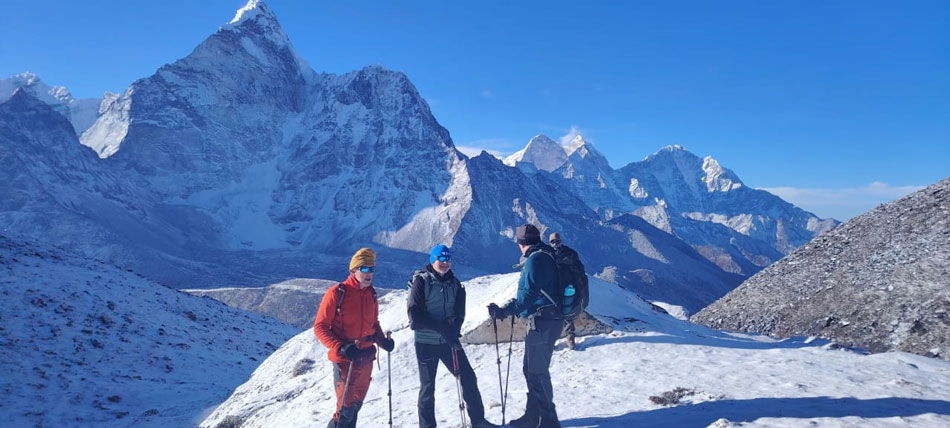Everest Base Camp Cho La Pass Trek by Road (Without Flight)
The Everest Base Camp Cho La Pass Trek by road offers more than just a mountain view. It’s an adventure of a lifetime without take a flight to Lukla. This journey is full of winding trails, turquoise lakes, ancient Sherpa culture, and breathtaking scenery. This incredible journey is now accessible by road, adding a whole new dimension to trekking in the Everest region. Imagine you are swapping a bumpy flight for a scenic road trip through the countryside of Nepal, passing through terraced fields, deep valleys, and remote villages. Now, let’s take a closer look.

Table of Contents
- Why Choose the Road Route for EBC Chola Pass Trek
- Overview of the Everest Base Camp Cho La Pass Trek
- What Makes Gokyo Lake Special?
- Starting Point: Drive from Kathmandu to Surke
- The Journey from Surke to Namche Bazaar
- Trek to Everest Base Camp: Highlights
- Conquering Cho La Pass: A Rewarding Challenge
- Gokyo Valley: A Hidden Himalayan Paradise
- Climbing Gokyo Ri: A View You’ll Never Forget
- Cultural Encounters: Sherpa Life and Monasteries
- Day to Day Itinerary of EBC Cho La Pass Trek by Road
- Accommodation and Meals on the Trek
- Best Time to Trek: Seasons and Weather
- Packing Essentials and Gear Tips
- Physical Fitness and Acclimatization Tips
- Conclusion
- FAQs
Why Choose the Road Route for EBC Chola Pass Trek
Flying to Lukla has long been the traditional entry to the Everest region, but it’s also weather-dependent and often risky. The road journey from Kathmandu to Surke offers a safer and more scenic alternative. It gives trekkers a gradual altitude gain, which helps with acclimatization and makes the adventure more accessible for people wary of small aircraft.
Overview of the Everest Base Camp Cho La Pass Trek
This trek combines everything you could ask for in a Himalayan adventure — Everest Base Camp, the high mountain Cho La Pass, and the shimmering Gokyo Lakes. Over the course of about 18–20 days, you will:
Travel by road Kathmandu to Salleri to Surke.
Trek to Everest Base Camp (5,364 m).
Cross the rugged Cho La Pass (5,420 m).
Explore the mesmerizing Gokyo Valley and Lakes.
Return by foot to Surke and drive back to Kathmandu.
What Makes Gokyo Lake Special?
Gokyo is not just a single lake; it’s a system of six glacial lakes, sitting at altitudes between 4,700m and 5,000m. The lakes are sacred to both Hindus and Buddhists. On a clear day, their turquoise waters reflect the surrounding snowy peaks — a sight straight out of a fantasy novel.
The nearby Gokyo Ri (5,360m) offers one of the best panoramic views of the Everest region, including Mount Everest, Lhotse, Makalu, and Cho Oyu.
Starting Point: Drive from Kathmandu to Surke
Your road adventure begins in Kathmandu. From there, it’s a long but scenic drive through Salleri, and finally to Surke, a village recently connected by road and now a gateway to the Everest region.
The journey takes around 14 hours, but it offers a window into rural Nepal, with tea shops, green hills, and cheerful locals along the way.
The Journey from Surke to Namche Bazaar
After reaching Surke, your trek officially begins. Over a few days, you’ll walk through:
Phakding — lush forests and rivers.
Namche Bazaar — the vibrant heart of the Khumbu region, where trekkers rest and acclimatize.
Namche is bustling with bakeries, gear shops, and cafes. It’s the perfect place to catch your breath and soak in the atmosphere.
Trek to Everest Base Camp: Highlights
From Namche, the trail follows the Dudh Koshi River and climbs toward:
Tengboche Monastery: spiritual hub of the region.
Dingboche: ideal for acclimatization.
Everest Base Camp: standing here, surrounded by icefalls and giant peaks, is an emotional moment for many.
Sunsets and sunrises around Kala Patthar (5,545m) offer unparalleled views of Everest.
Conquering Cho La Pass: A Rewarding Challenge
Now comes the more adventurous part — crossing Cho La Pass. It’s steep, icy, and physically demanding. But the views from the top? Absolutely worth every step.
Expect to cross glaciers, rocky slopes, and sometimes snow. This is where your inner explorer comes alive. A good guide is essential for safety here.
Gokyo Valley: A Hidden Himalayan Paradise
Once over Cho La, you enter the serene Gokyo Valley. Fewer trekkers make it here, which makes it feel untouched and peaceful.
Highlights include:
Ngozumpa Glacier: the largest in Nepal.
Gokyo Lakes: crystal-clear and surrounded by giants.
Warm lodges with views you’ll remember forever.
Climbing Gokyo Ri: A View You’ll Never Forget
If Everest Base Camp felt incredible, Gokyo Ri will blow you away. The early morning climb is steep, but standing at the summit, you see four of the world’s highest peaks in one frame. Gokyo Ri is often called the best viewpoint in the Everest region.
Cultural Encounters: Sherpa Life and Monasteries
Trekking here is not just about nature. It’s also about people.
You’ll meet Sherpa families, visit Buddhist monasteries, and see prayer wheels, flags, and mani stones along the trail. These experiences add soul to the journey, making it more than just a physical trek.
Day to Day Itinerary of EBC Cho La Pass Trek by Road
| Day 1: Early morning drive from Kathmandu to Salleri (Alt. 2362m/7749ft). Driving Distance 265 Km. Driving 9 hours. Overnight at Tea House. |
| Day 2: Drive from Salleri to Surke(Alt. 2730m/8957ft). Driving 5/6 hours. Overnight at Tea House |
| Day 3: Trek from Surke to Phakding (Alt. 2657m/8717ft). Walking 5 hours. Overnight at Tea House. |
| Day 4: Trek from Phakding to Namche Bazaar (Alt. 3441m/11289ft). Walking 6 hours. Overnight at Tea House. |
| Day 5: Acclimatization day. Day trip to Shyangboche and Khumjung Village (Alt. 3780m/12402ft). Walking 4/5 hours. Overnight at Tea House. |
| Day 6: Trek from Namche Bazaar to Tengboche (Alt. 3860m/12664ft). Walking 6 hours. Overnight at Tea House. |
| Day 7: Trek from Tengboche to Dingboche (Alt. 4350m/14272ft). Walking 5/6 hours. Overnight at Tea House. |
| Day 8: Acclimatization day. Walk around Dingboche. Walk around for 3 hours. Overnight at Tea House. |
| Day 9: Trek from Dingboche to Lobuche (Alt. 4910m/4910ft). Walking 6 hours. Overnight at Tea House. |
| Day 10: Trek from Lobuche to Everest Base Camp (Alt. 5365m/17602ft) then back to Gorak Shep. Walking 8 hours. Overnight at Tea House. |
| Day 11: Morning hike up to Kalapatthar (Alt. 5555m/18225ft) then trek to Dzongla (4830m/15850ft). Walking 7 hours. Overnight at Tea House. |
| Day 12: Trek from Dzongla to Thangnak (4850m/15912ft) crossing Cho La Pass (5330 m/17487ft). Walking 7 to 8 hours. Overnight at Tea House. |
| Day 13: Trek from Thangnak to Gokyo Lake (4750m/15584ft). Walking 4/5 hours. Overnight at Tea House. |
| Day 14: Hike up to Gokyo Ri (5357m/17575 ft) & rest day in Gokyo. Walking 3/4 hrs. Overnight at Tea House. |
| Day 15: Trek from Gokyo Lake to Dole (4110m/13484ft). Walking 6 hours. Overnight at Tea House. |
| Day 16: Trek from Dole to Namche Bazaar (3440m/11286ft). Walking 5/6 hours. Overnight at Tea House. |
| Day 17: Trekking from Namche Bazaar to Surke (Alt. 2290m/7513ft). Walking 7:30 hours. Overnight at Tea House. |
| Day 18: Drive from Surke to Salleri (Alt. 2362m/7749ft). 6/7 hours. Overnight at Tea House. |
| Day 19: Drive from Salleri to Kathmandu (Alt. 1400m/4593ft). Driving Distance 265 Km. Driving 9/10 hours. |
Accommodation and Meals on the Trek
Teahouses dot the entire trail. They’re cozy and offer:
Warm meals like dal bhat, noodles, and pancakes.
Basic rooms with shared bathrooms.
Friendly hosts who share stories and laughter.
It’s not five-star living, but it’s full of heart and charm.
Best Time to Trek: Seasons and Weather
The best time for this trek is:
Spring (March to May): Rhododendrons bloom, clear skies.
Autumn (September to November): Dry trails, excellent visibility.
It will be good if you avoid the monsoon and winter unless you’re experienced and well-equipped.
Packing Essentials and Gear Tips
Bring layers. The weather changes quickly. Essentials include:
Waterproof jacket and pants.
Thermal base layers.
Down jacket, gloves, and hat.
Trekking poles, boots, and sunglasses.
A good backpack and sleeping bag.
Renting in Kathmandu is also an option if you’re traveling light.
Physical Fitness and Acclimatization Tips
This trek is challenging. To prepare:
Walk or hike regularly before the trip.
Do cardio workouts like running or cycling.
Practice long walks with a loaded backpack.
Acclimatization days in Namche and Dingboche are crucial. Hydrate, rest, and climb high, sleep low.
Conclusion
The Everest Base Camp Cho La Pass Trek with Gokyo Lake by road is more than a trek. It’s a journey through Nepal’s heart, from bustling cities to quiet mountain paths. You’ll experience culture, challenge your limits, and witness nature in its purest form — all without taking a risky flight.
So, pack your bag, tie your boots, and get ready to write your own Himalayan story.
Excellent Himalaya Trek and Expedition is the leading local trekking operator for Everest Base Camp Chola Pass Trek by road. For any further information about this trek, please email at [email protected] or WhatsApp at +977 9851203181.
FAQs
1. Can I really reach Everest Base Camp by road now?
Yes, you can drive to Tham Danda, which bypasses the flight to Lukla and starts your trek from a lower altitude.
2. Is Cho La Pass difficult to cross?
Yes, it’s one of the more challenging parts of the trek with snow, ice, and steep ascents. Proper gear and a guide are strongly recommended.
3. How many days does this trek take?
Typically, it takes 18 to 20 days, including road travel, acclimatization, and exploration of Gokyo Valley.
4. Is Gokyo Ri better than Kala Patthar?
Both offer amazing views. Kala Patthar is closer to Everest, while Gokyo Ri gives a wider panorama of four 8000-meter peaks.
5. What kind of fitness level do I need?
You don’t need to be an athlete, but you should be in good physical condition. Regular hiking experience and stamina are essential.




